Multiple Flutes
- 1
- 2
Haydn – Adagio from Symphony No.24 – trans. Solo Flute and Flute Choir
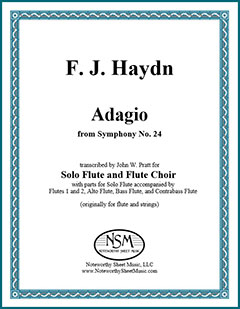 Adagio from Symphony No.24 by F. J. Haydn
Adagio from Symphony No.24 by F. J. Haydn
Transcribed for Solo Flute accompanied by Flute Choir, by John W. Pratt (originally for flute and strings)
Score and Parts for Solo Flute, Flutes 1 and 2, Alto Flute, and Bass Flute/Contrabass Flute, PDF $7.99
Haydn wrote his Symphony No.24 in 1764. Its second movement is a beautiful Adagio for flute solo accompanied by strings. The string parts are simple, with no double stops or extreme high notes, so they can be played comfortably by corresponding members of the flute family, except for a few low notes. This transcription for flute choir is therefore straightforward except that the alto flute sometimes plays violin notes that C-flutes cannot play or can use support playing, and similarly the bass flute plays some viola notes instead of or in addition to the alto flute playing them. Notes taken from the cello in its lowest octave have been raised an octave for bass flute, but there are fewer than one might expect. Perhaps one reason is that Haydn expected a (string) bass to be doubling the cello an octave lower, playing from the same part. If a contrabass flute is available, it can double the bass flute similarly, serving even more to enrich the sound. —adapted from JWP’s preface to the edition
Listen to a computer-generated audio sample.
Score, 5 pages; Parts for Solo Flute, 2 pages; Flutes 1 and 2, 2 pages; Alto Flute, 1 page; Bass Flute/Contrabass Flute, 1 page; Total 19 pages.
PreviewHaydn – Hob. II:21 – arr. Flute Quartet
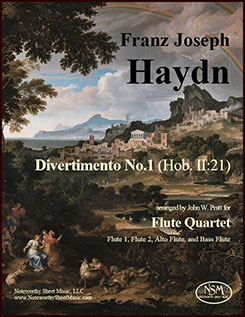 Divertimento No. 1 (Hob. II:21; Op. 2 No. 3) by Franz Joseph Haydn
Divertimento No. 1 (Hob. II:21; Op. 2 No. 3) by Franz Joseph Haydn
Arranged for Flute Quartet by John W. Pratt (originally for string quartet plus 2 horns)
Score and Parts for Flute 1, Flute 2, Alto Flute, and Bass Flute, PDF $11.97
excerpted from John W. Pratt’s © preface to the edition:
“Haydn (1732-1809) is credited with developing the classical forms of both the string quartet and the symphony, starting from the loose structures and permissive instrumentation of Baroque instrumental music. … His first string quartets are his Opus 1 Nos. 1-4 and 6, and Opus 2 Nos. 1-6, thus eleven. Opus 1 No. 5 is somewhat later, added to make a set of 6, apparently a perfect number in music publication as well as in mathematics. Opus 2 Nos. 3 and 5 are quartet arrangements of two divertimentos including also two horns and listed in the Hoboken catalogue as II:21 and 22 … The spirit and spiritedness of the two divertimentos suit them to flute quartet, as does the distribution of activity. In addition, a flute quartet combines the unified timbre of a string quartet with the wind sound of the horns, while the early string quartets do not exploit the string sound per se. Transposition up a step puts the cello and viola parts of Hob. II:21 mostly within the bass and alto flute ranges and makes the violin parts if anything more comfortable for C flutes.”
There are 5 movements in total: I-Allegro molto, II-Minuet, III-Adagio, IV-Minuet, and V-Finale Allegro. To get some sense of how the Op. 2 No. 3 quartet works with flutes in lieu of strings, listen to this computer-generated audio clip of the first movement—realizing it will of course sound considerably better played in-person on real instruments.
Score, 11 pages; Flute 1 part, 6 pages; Flute 2 part, 6 pages; Alto Flute part, 5 pages; Bass Flute part, 5 pages; Total, 38 pages.
PreviewHaydn – Hob. II:22 – arr. Flute Quartet
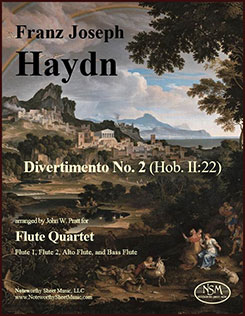 Divertimento No. 2 (Hob. II:22; Op.2, No.5) by Franz Joseph Haydn
Divertimento No. 2 (Hob. II:22; Op.2, No.5) by Franz Joseph Haydn
Arranged for Flute Quartet by John W. Pratt (originally for string quartet plus 2 horns)
Score and Parts for Flute 1, Flute 2, Alto Flute, and Bass Flute, PDF $10.97
This is the second of Haydn’s two divertimenti, Hob. II:21 and II:22, that John Pratt has arranged for flute quartet, scored for two C-flutes, alto flute, and bass flute. Both divertimenti were written originally for string quartet plus two horns, but were later adapted by others as quartet-only versions identified as Opus 2, No.3 and No.5. Please see the text excerpted from Mr. Pratt’s preface to his arrangement of Haydn’s Divertimento No.1 (Op.2, No.3) for additional information that applies to both these works. There are 5 movements in Op.2, No.5: I-Presto, II-Minuet, III-Largo, IV-Minuet, and V-Finale Presto. Listen to this computer-generated audio clip from the second movement Minuet to get a sense of how the quartet sounds with flutes in lieu of strings.
Score, 10 pages; Flute 1 part, 4 pages; Flute 2 part, 4 pages; Alto Flute part, 4 pages; Bass Flute part, 3 pages; Total, 28 pages.
PreviewHaydn – Symphony 13 - arr. for Multiple Flutes
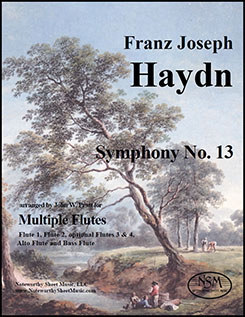 Symphony 13, by Franz Joseph Haydn
Symphony 13, by Franz Joseph Haydn
Arranged for Multiple Flutes by John W. Pratt
Score and Parts for Flutes 1-4, Alto Flute, Bass Flute; PDF $23.95
This arrangement of Haydn’s Symphony No.13 is for a flute ensemble of any size including at least one bass, one alto, and two concert flutes. Third and fourth concert flute parts are also provided, and all parts can be doubled at will. If a contrabass flute is available, it can double the bass flute, serving to deepen and enrich the sound. The second movement is a beautiful Adagio cantabile, originally for solo cello accompanied by strings, which transcribes nicely for alto flute accompanied by the rest of the flute family. The trio of the symphony’s third movement has a delightful solo flute part with only string accompaniment. A large flute ensemble would be about the size of Haydn’s core orchestra at the time this symphony was composed; in our arrangement, Haydn’s original key has been raised a minor third to better suit the natural range of a flute ensemble.
Score, 17 pages; separate parts for Flute 1, Flute 2, Flute 3, and Flute 4, 6 pages each; Alto Flute part, 7 pages; Bass Flute part, 6 pages; Total, 68 pages.
PreviewHerman - Grands Duos Concertantes - Two Flutes
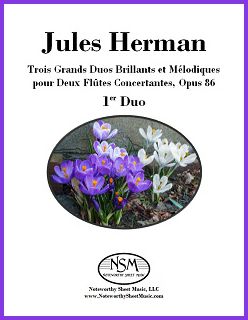 Trois Grands Duos Brillants et Mélodiques pour Deux Flûtes Concertantes, by Jules Herman
Trois Grands Duos Brillants et Mélodiques pour Deux Flûtes Concertantes, by Jules Herman
New Editions by Noteworthy Sheet Music, with a Foreword by P. H. Bloom
Duo 1: Flute 1 Part, Flute 2 Part, and Mini-Score ― PDF $17.98
Duo 2: Flute 1 Part, Flute 2 Part, and Mini-Score ― PDF $21.75
Duo 3: Flute 1 Part, Flute 2 Part, and Mini-Score ― PDF $17.98
Jules Herman's Grands Duos Concertantes (Opus 86) are works of ingenuity, charm, brilliance, grace, and humor. Long overlooked, they are extraordinarily fine examples of concert-worthy duets of the late 19th century. Originally published by Choudens in Paris about 1885, the Grand Duos were dedicated to composer François-Auguste Gevaert (1828–1908), then director of the Royal Conservatory of Brussels. Flutists will find these works challenging and rewarding, teachers of advancing students will be amazed by their utility, and audiences will be enchanted. (excerpted from PHB's © foreword)
Note that these duets make for excellent sight-reading training ... the music is interesting and demanding, and the parts are nicely balanced. All three duets have three movements each. Duo 1: Allegro moderato; Adagio sostenuto; and Rondo allegro. Duo 2: Moderato; Scherzando; and Polonaise. Duo 3: Allegretto vivace con brio; Air Varié, Andante; and Boléro, Moderato.
McDonald - Three Four-Note Flute Duets - Two Flutes
 Three Four-Note Flute Duets, Op.448b, by John D. McDonald
Three Four-Note Flute Duets, Op.448b, by John D. McDonald
Contemporary Composition for Two Flutes, PDF $2.99
"Composed for Ethel Farny and her flute students at the Rivers Music School, these short duets sprout initially from the first flute/violin duet of Several Strands, Op. 448a. This Grazioso is indeed made from only four pitches. Similarly, Murmurando confines itself to a four-note knot until its final dyad. The third duet, Con Eleganza, stretches the four-note concept a bit more. Each instrument has its own four-pitch pattern, and a coda leaves the four-note idea behind all together, concluding the set with six slower, somewhat more chromatic bars that could very well lead to future music of more emotional complexity. Perhaps there will be more duets to come." ― John McDonald, November 2009
John McDonald is a member of The Mockingbird Trio, directs the Tufts Composers Concert Series, and serves on the boards of several performance organizations in New England. He has recently fulfilled commissions from The Chamber Orchestra of Boston, pianist David Holzman, The Firebird Ensemble (for an Apple Hill Center for Chamber Music Residency, with support from a Meet the Composer MetLife Creative Connections Award), and the ANA Trio (Fredonia University; soprano, cello, and piano), among others. Recent performances by McDonald at the Goethe Institut of Boston, at Tufts, and at many other venues have been highly acclaimed.
Score for Two Flutes, 2 pages; Total, 4 pages.
Mozart - Quintet, K.515, arr. Flute Quintet
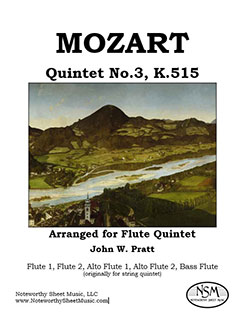 Quintet, K.515, by Wolfgang Amadeus Mozart
Quintet, K.515, by Wolfgang Amadeus Mozart
Arranged for Flute Quintet by John W. Pratt (originally for strings)
Score and Parts for Flute 1, Flute 2, Alto Flute 1, Alto Flute 2, and Bass Flute, PDF $26.50
Wolfgang Amadeus Mozart wrote six quintets for 2 violins, 2 violas, and cello. Two of these, K.515 in C major and K.516 in G minor, are generally regarded as high points in Mozart’s, and indeed all, chamber music. Performances of K.515 are infrequent, far less than such great music deserves, since there is not enough repertoire to support permanent string quintets and string quartets have an abundance of great music to play without needing to find an additional violist. Adaptation to flute quintet is thus particularly apropos, as its textural possibilities apply also to a flute quintet, and its musical and emotional content are well worth viewing through the prism of five flutes. Our edition includes a score as well as parts for two concert flutes, two alto flutes, and bass flute. (adapted from jwp’s foreword to the edition)
Score, 37 pages; Flute 1, 16 pages of music; Flute 2, 14 pages of music; Alto Flute 1, 16 pages of music; Alto Flute 2, 14 pages of music; and Bass Flute, 14 pages of music; Total, 124 pages.
PreviewMozart - Quintet, K.516 - arr. Flute Quintet
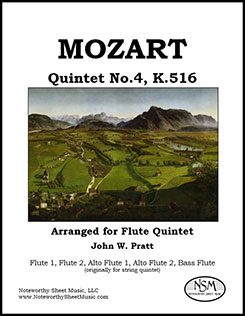 Quintet, K.516 by Wolfgang Amadeus Mozart
Quintet, K.516 by Wolfgang Amadeus Mozart
Arranged for Flute Quintet by John W. Pratt (originally for strings)
Score and Parts for Flute 1, Flute 2, Alto Flute 1, Alto Flute 2, and Bass Flute, PDF $23.50
Wolfgang Amadeus Mozart (1756-1791) wrote six quintets for 2 violins, 2 violas, and cello. Two of these, K.515 in C major and K.516 in G minor, are generally regarded as high points in Mozart’s, and indeed all, chamber music. Adaptation of K.516 to flute quintet is apropos, as its textural possibilities apply also to a flute quintet, and its musical and emotional content are well worth viewing through the prism of five flutes. In John Pratt’s arrangement, the work has been transposed up a step to better adapt to a flute ensemble. Our edition includes a score as well as parts for two concert flutes, two alto flutes, and bass flute.
Score, 30 pages; Flute 1, 14 pages; Flute 2, 13 pages; Alto Flute 1, 14 pages; Alto Flute 2, 13 pages; and Bass Flute, 11 pages of music; Total, 106 pages.
PreviewSamolis - Duo for Two Flutes - Flutes
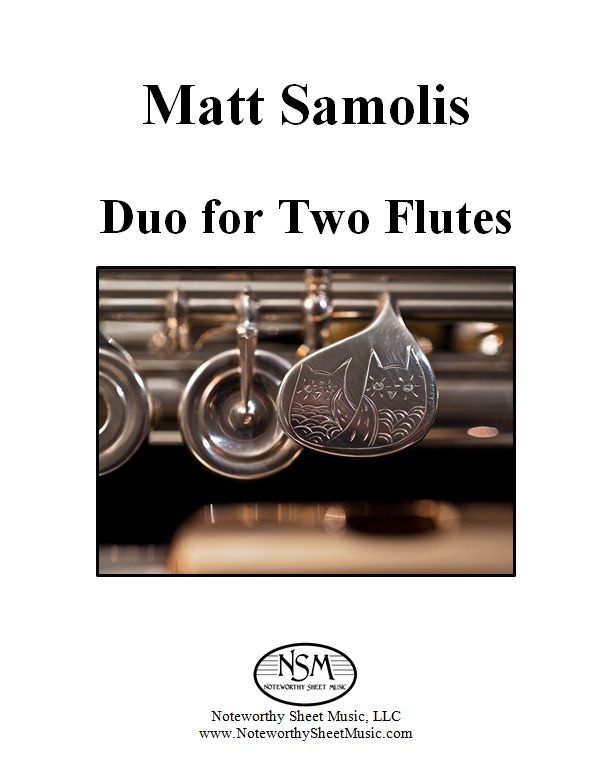 Duo for Two Flutes, by Matt Samolis
Duo for Two Flutes, by Matt Samolis
Contemporary Composition for Two Flutes, PDF $17.99
Duo for Two Flutes was written using twelve tone techniques. The original tone row was divided in half, with each set of six tones being used to generate one of the flute parts. Frequently changing time signatures reflect compositional organization of the pitches, and does not establish meter. The piece has a playful, somewhat mechanical feel. 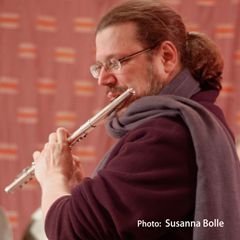 To listen to bits of a recording of Duo for Two Flutes performed by Matt Samolis and Peter H. Bloom, click on the icons below.
To listen to bits of a recording of Duo for Two Flutes performed by Matt Samolis and Peter H. Bloom, click on the icons below.
Score for Two Flutes, 8 pages; Total, 11 pages.
PreviewSlawinski - 5 Dessert Rounds - Two Flutes
 5 Dessert Rounds, by Zenon Slawinski
5 Dessert Rounds, by Zenon Slawinski
Contemporary Composition for Two Flutes
Score, PDF $4.99
Excerpts from the preface to the edition by Zenon Slawinski:
In most classic rounds the second voice begins and plays (or sings) the same melody as the first voice. That's the case here too for three of the five Dessert Rounds. Rounds 3 and 4 are different. In Round 3 - The Chocolate Chocolate Chip Cookie - the second voice plays the same melody but a third higher. In Round 4 - Sweet Potato Flan - the second voice plays the melody a 4th higher. // The Dessert Rounds are relatively simple and should not pose any difficulties for most intermediate players, although there are some tricky meter changes in Round 2 - Chocolate Mint Ice Dream - if you practice this slowly you'll soon be able to get past the meter changes and simply enjoy your dessert. // Round 4 - Sweet Potato Flan - is written in 7/4. // I purposely left off many performance markings so the players can make their own mark on the compositions. Interpret these pieces freely and have fun.
Zenon Slawinski, September 12, 2014
--------------------------------------------------------------------------------------------------------------
Click to listen to a few audio samples of the Dessert Rounds:
Score for two flutes, 6 pages; Total, 10 pages.
Preview- 1
- 2
